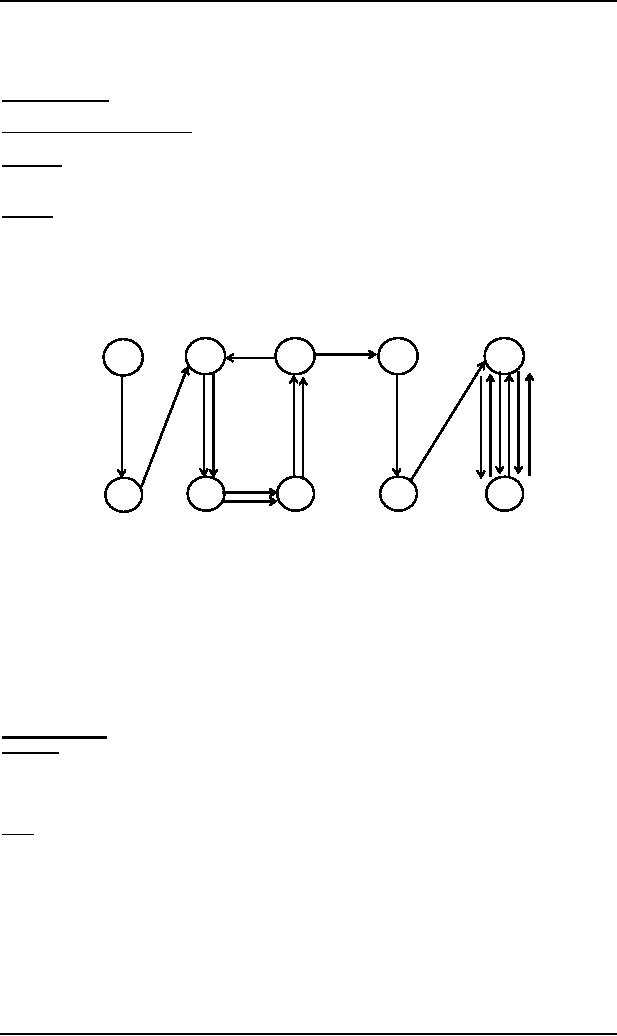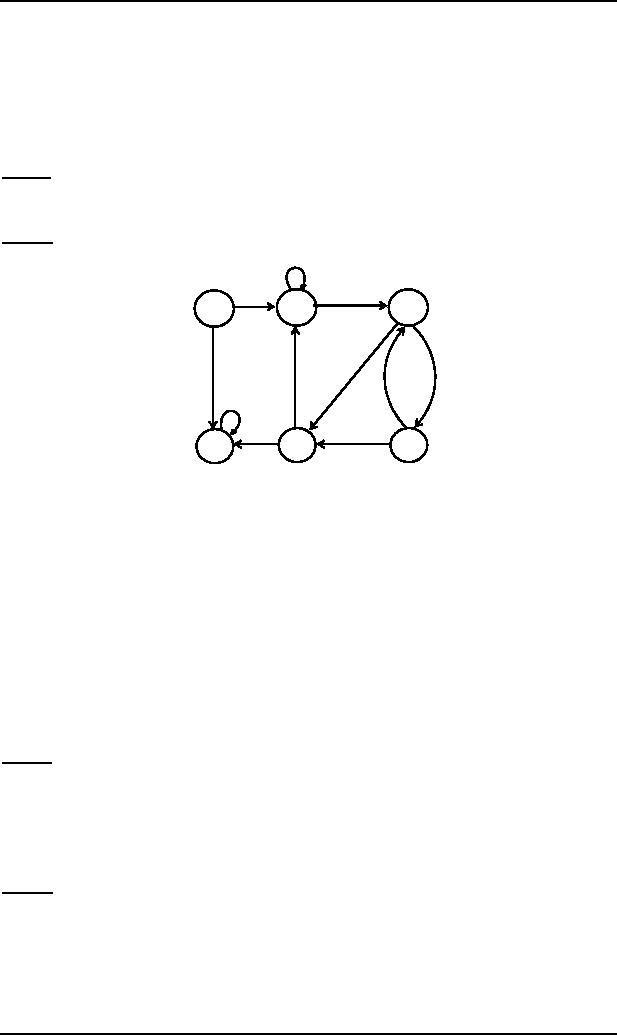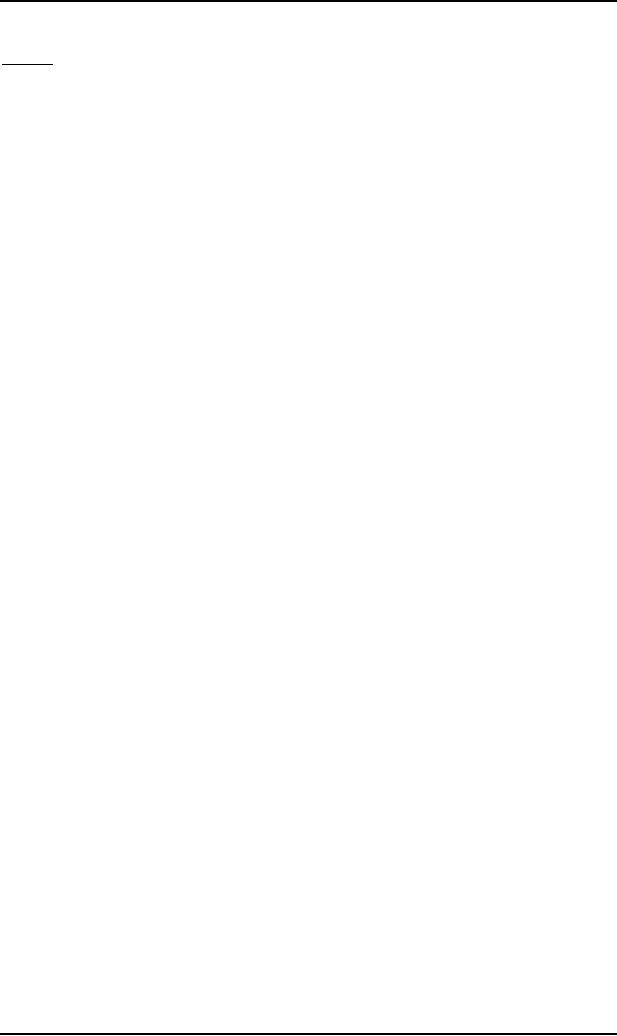 |
Pumping Lemma |
| << Nonregular languages |
| Pumping Lemma version II >> |

Theory of
Automata
(CS402)
Theory of
Automata
Lecture
N0. 26
Reading
Material
Introduction
to Computer Theory
Chapter
10
Summary
Example
of nonregular language, pumping
lemma version I, proof,
examples
Example
Consider
the language L = {Λ, ab,
aabb, aaabbb, ...} i.e.
{an bn :
n=0,1,2,3,...}
Suppose,
it is required to prove that
this language is nonregular. Let, contrary, L be a
regular language then
by
Kleene's
theorem it must be accepted by an
FA, say, F. Since every FA
has finite number of states
then the
language
L (being infinite) accepted by F
must have words of length more than
the number of states.
Which
shows
that, F must contain a circuit.
For
the sake of convenience suppose
that F has 10 states. Consider
the word a9 b9 from the language L
and let
the
path traced by this word be
shown as under
b
a
7
1-
3
5
9+
b
b
a
a
a
a
b
b
a
8
4
6
10
2
But,
looping the circuit
generated by the states
3,4,6,5,3 with a-edges once
more, F also accepts the
word a9+4 b9,
while
a13b9 is
not a word in L. It may also
be observed that, because of the
circuit discussed above, F
also
accepts
the words a9(a4 )m b9, m =
1,2,3, ...
Moreover,
there is another circuit
generated by the states
9,10,9. Including the
possibility of looping this
circuit,
F accepts
the words a9(a4 )m b9(b2 )n where m,n=0,1,2,3,...(m
and n not being 0 simultaneously).Which
shows
that F
accepts words that are not
belonging to L.
Similarly
for finding FAs accepting
other words from L, they
will also accept the words
which do not belong to
L.
Thus
there is no FA which accepts
the language L. which shows,
by Kleene's theorem, that
the language L can't
be
expressed by any regular
expression. It may be noted
that apparently anbn seems to be a regular
expression of
L, but in fact it is
not. The observations made
from this example,
generalize the theorem (also called
the
Pumping lemma)
regarding the infinite
regular language as
follows
Pumping
Lemma
Statement
Let L be
any infinite regular language (that
has infinite many words),
defined over an alphabet � then
there exist
three
strings x, y and z belonging to
�* (where y is not
the null string) such
that all the strings of
the form xynz
for
n=1,2,3, ... are the words in
L.
Proof
If L is a
regular language, then according to
Kleene's theorem, there
exists an FA, say, F that
accepts this
language.
Now F, by definition, must
have finite no of states
while the language has
infinitely many words,
which
shows that there is no restriction on
the length of words in L, because if
there were such restriction
then
the
language would have finite
many words.
Let w be
a word in the language L, so
that the length of word is
greater than the number of
states in F. In this
case
the path generated by the
word w, is such that it
cannot visit a new state
for each letter i.e.
there is
a circuit
in this
path.
The
word w, in this case, may be
divided into three
parts
The
substring which generates
the path from initial
state to the state which is
revisited first while reading
the
word w.
This part can be called x and x
can be a null string.
77

Theory of
Automata
(CS402)
The
substring which generates
the circuit starting from
the state which was
lead by x. This part can be
called as
y which
cannot be null string.
The
substring which is the
remaining part of the word
after y, call this part as z. It
may be noted that this
part
may be
null string as the word may
end after y or z part may
itself be a circuit.
Thus the
word may be written as w =
xyz where x,y and z are the
strings, also y can't be a
null string.
Now
this is obvious that,
looping the circuit
successively, the words
xyyz, xyyyz, xyyyz, ... will
also be
accepted
by this FA i.e.
xynz, n=1,2,3, ... will be words
in L.
Remark: In
the above theorem, it is not affected if
the z-part has circuit. To
prove the theorem it is only
to find a
circuit
and then looping that
circuit, is all that is
needed. While looping the
circuit the volume of the
string y
(or z) is
pumped, so the theorem is
also called the Pumping lemma.
Following are the
examples
Example
Consider
the following 5 states FA,
say, F which accepts an
infinite language
a
b
2+
3
1-
b
b
a
a
a
b
a,b
a
b
6+
5
4
Let
the word w = bbbababa,
belonging to the language L, so
that the length of word is
greater than 6 (the
number of
states in F).
In this
case the path generated by
this word is such that it
cannot visit a new state
for each letter i.e.
there is
a
circuit
in this path.
The
word w, in this case, may be
divided into three
parts.
The
substring which generates
the path from initial
state to the state which is
revisited first while reading
the
word w.
This can be called as part x and
this may be null
string.
The
substring which generates
the circuit starting from
the start state which
was lead by x, this part can
be called
as y and
this cannot be null
string.
The
substring which is the
remaining part of the word
after y, this part can be called as z. It
may be noted that
this part
may be null string as the
word may end after y or
z-part may itself be a circuit.
Thus the
word w may be written as w =
xyz, where x,y,z are strings
belonging to �* and y cannot be
null string.
The
state 2 is such that it is
revisited first while reading
the word w. So the word w
can be decomposed,
according to
pumping lemma, as w = xyz =
(b)(bba)(baba)
If y-part of w is
continuously pumped, the resulting
strings will be accepted by F
and hence will be words in
the
language
accepted by F. Thus, by pumping
lemma, the language accepted
by F is regular.
Remark: If
the pumping lemma is applied
directly on the language L =
{an bn :
n=0,1,2,3,...}, it can be observed
that
for the word w =
(aaa)(aaaabbbb)(bbb)
where x =
aaa, y = aaaabbbb and z =
bbb
xyyz
will contain as many number of a's as
there are b's but this
string will not belong to L because
the
substring
ab can occur at the most
once in the words of L, while
the string xyyz contains the
substring ab twice.
On the
other hand if y-part consisting of only
a's or b's, then xyyz
will contain number of a's different
from
number of
b's. This shows that
pumping lemma does not hold
and hence the language is
not regular.
Example
Consider
the language EQUAL, of
strings, defined over
Σ={a,b}, with number of a's equal to
number of b's,
i.e.
EQUAL
= {Λ
,ab,aabb,abab,baba,abba,...}
From
the definition of EQUAL,
it is
clear that {an bn } = a* b* Č EQUAL
Obviously
a* b* defines a
regular language while {an bn } has been
proved nonregular.
Using
the theorem that intersection of
two regular languages is,
regular; it can be proved
that the EQUAL
is
not
regular.
Because if it is considered regular
then the language {an bn } will, being intersection of
regular
languages,
be regular language, which is
impossible.
78

Theory of
Automata
(CS402)
Following
are the remarks regarding
these examples
Remarks
In the
previous examples, languages
are proved to be regular or
nonregular using pumping lemma. In fact
to
prove a
certain language to be regular, it is not needed to
use the full force of
pumping lemma i.e.
for a
word
with
length greater than the number of
states of the machine,
decomposing the word into
xyz and for a
language
to be
regular it is sufficient that
xyyz is in L. The condition
that xynz is in L for
n>2, provides that the
language
is
infinite.
Consider
the language PALINDROME and
a word w = aba belonging to
PALINDROME. Decomposing
w = xyz
where x=a, y=b, z=a. It can
be observed that the strings of
the form xynz for
n=1,2,3, ..., belong to
PALINDROME.
Which shows that the
pumping lemma holds for
the language PALINDROME
(which is non
regular
language). To overcome this drawback of pumping
lemma, a revised version of
pumping lemma is to be
introduced.
79
Table of Contents:
- What does automata mean, Introduction to languages
- Kleene Star Closure, Recursive definition of languages
- Regular Expression, Recursive definition of Regular Expression
- Equivalent Regular Expressions
- Finite Automaton
- Equivalent FAs
- FA corresponding to finite languages
- Examples of TGs: accepting all strings
- Generalized Transition Graphs
- Nondeterminism, Kleene’s Theorem
- Proof(Kleene’s Theorem Part II)
- Kleene’s Theorem Part III
- Concatenation of FAs
- Closure of an FA
- Nondeterministic Finite Automaton, Converting an FA to an equivalent NFA
- NFA with Null String
- NFA and Kleene’s Theorem
- NFA corresponding to Concatenation of FAs
- Distinguishable strings and Indistinguishable strings
- Finite Automaton with output, Moore machine
- Mealy machine
- Equivalent machines
- Mealy machines in terms of sequential circuit
- Regular languages, Complement of a language
- Nonregular languages
- Pumping Lemma
- Pumping Lemma version II
- Pseudo theorem
- Decidability
- finiteness of a language
- Context Free Grammar (CFG), CFG terminologies
- Trees
- Polish Notation (o-o-o)
- Total language tree, Regular Grammar
- Null Production
- Chomsky Normal Form (CNF)
- A new format for FAs
- Nondeterministic PDA
- PDA corresponding to CFG
- Conversion form of PDA
- Conversion Form, Joints of the machine
- Row language, Nonterminals
- Non-Context-Free language, Pumping lemma for CFLs
- Decidablity, Parsing Techniques
- Turing machine